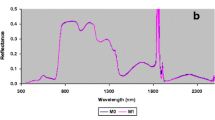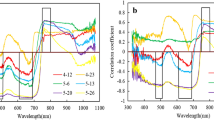Abstract
As wheat represents the main staple food and strategic crop in Egypt and worldwide and since remote sensing satellite imagery is the tool to obtain synoptic, multi-temporal, dynamic, and time-efficient information about any target on the Earth, the main objective of the current study is to use remote sensing satellite imagery to generate remotely sensed empirical preharvest wheat yield prediction models. The main input parameters of these models are spectral data either in the form of spectral reflectance data released from Satellite Pour l’Observation de la Terre (SPOT) 4 satellite imagery or in the form of spectral vegetation indices. The other input factor is leaf area index (LAI) that was measured by LAI Plant Canopy Analyzer. The four spectral bands of SPOT4 imagery are green, red, near-infrared, and middle infrared; the five vegetation indices that are forms of ratios between red and near-infrared bands are normalized difference vegetation index, ratio vegetation index, soil-adjusted vegetation index, difference vegetation index, and infrared percentage vegetation index. Another vegetation index is green vegetation index that is calculated through a ratio between green band and near-infrared band. Each of the above-mentioned factors was used as an input factor against wheat yield to generate wheat yield prediction models. All generated models are site-specific limited to the area and the environment and could be applicable under similar conditions in Egypt. The study was carried out in Sakha experimental station by using the dataset from two wheat season 2007/2008 and 2009/2010. The total wheat area was 1.3 ha cultivated by Sakha 93 cultivar. Modeling and validation process were carried out for each season independently. Modeled yield was tested against reported yield through two common statistical tests; the standard error of estimate between modeled yield and reported yield, and the correlation coefficient for a direct regression analysis between modeled and reported yield with each generated model. Generally, as shown from the correlation coefficient of the generated models, green and middle infrared bands did not show good accuracy to predict wheat yield, while the other spectral bands (red and near-infrared) bands showed high accuracy and sufficiency to predict yield. This was proven through the correlation coefficient of the generated models and through the generated models with the wheat crops for the two seasons. Accordingly, the green vegetation index that is generally calculated from green and near-infrared bands showed relatively lower accuracy than the rest of the vegetation index models that are calculated from red and near-infrared bands. LAI showed high accuracy to predict yield as shown from the statistical analysis. The models are applicable after 90 days from sowing stage and applicable in similar regions with the same conditions.









Similar content being viewed by others
Reference
Aase JK, Siddoway FH (1981) Spring wheat yield estimates from spectral reflectance measurements. IEEE Trans Geosci Remote Sens 19(2):78–84
Ahlrichs JS, Bauer ME (1983) Relation of agronomic and multispectral reflectance characteristics of spring wheat canopies. Agron J 75:987–993
Baret F, Guyot G (1991) Potentials and limits of vegetation indices for LAI and APAR assessment. Remote Sens Environ 35:161–73
Bach H (1998) Yield estimation of corn based on multi-temporal LANDSAT-TM data as input for agrometeorological model. Pure Appl Opt 7:809–825
Chang KW, Shen Y, Lo JC (2005) Predicting rice yield using canopy reflectance measured at booting stage. Agron J 97:872–878
Crist EP (1984) Effects of cultural and environmental factors of corn and soybean spectral development pattern. Remote Sens Environ 14:3–13
Crippen RE (1990) Calculating the vegetation index faster. Remote Sens Environ 34:71–73
Daughtry CST, Bauer ME, Cresclius DW, Hixon MM (1980) Effects of management practices on reflectance of spring wheat canopies. Agron J 72:1055–1060
Hamar D, Ferncz C, Lichtenberger J, Tarcsai G, Ferncz A (1996) Yield estimation for corn and wheat in the Hungarian great plain using Landsat MSS data. Int J Remote Sens 17(9):1689–1699
Hartfield JL (1983) Remote sensing estimators of potential and actual crop yield. Remote Sens Environ 13:301–311
Hinzman LD, Bauer ME, Daughtry CST (1986) Effects of nitrogen fertilization on growth and reflectance characteristics of winter wheat. Remote Sens Environ 19:47–61
Holben BN, Tucker CJ, Fan CJ (1980) Spectral assessment of soybean leaf area and leaf biomass. Photogramm Eng Remote Sens 46(5):651–656
Huete ARA (1988) Soil adjusted vegetation index (SAVI). Remote Sens Environ 25:295–309
Jordan CF (1969) Derivation of leaf area index from quality of light on the forest floor. Ecology 50:663–666
Ma BL, Dwyer LM, Costa C, Cober ER, Morrison MJ (2001) Early prediction of soybean yield from canopy reflectance measurements. Agron J 93:1227–1234
Nemani RR, Running SW (1989) Testing a theoretical climate-soil-leaf area hydrological equilibrium of forests using satellite data and ecosystem simulation. Agric Forest Meteorol 44:245–260
Richardson AJ, Everitt JH (1992) Using spectra vegetation indices to estimate rangeland productivity. Geocarto Int 1:63–69
Shresthan RP, Naikaset S (2003) Agro-spectral models for estimating dry season rice yield in the Bangkok Plain of Thailand. Asian J Geoinformatics 4:11–19
Teng WL (1990) AVHRR monitoring of U.S. Crops during the 1988 drought. Photogramm Eng Remote Sens 56(8):1143–1146
Thiam S, Eastmen RJ (1999) Chapter on vegetation indices. In Guide to GIS and Image Processing, Volume 2; Idrisi Production: Clarke University, Worcester, MA, USA, 107–122
Tucker CJ (1979) Red and photosynthetic infrared linear combination for monitoring vegetation. Remote Sens Environ 8:127–150
Tuker CJT, Holben JR, McMutrey JE (1980) Relation of spectral data to grain yield variation. Photogramm Eng Remote Sens 46:657–666
Weiegand CL, Mass SJ, Aasse JK, Hartfield JL, Pinter PJ, Jackson RD, Kanemasu ET, Lapitan RL (1992) Multisite analyses of spectral-biophysical data for wheat. Remote Sens Environ 42:1–21
Weigand CL, Rechardson AJ, Escobar DE, Gerbermann AH (1990) Vegetation indices in crop assessment. Remote Sens Environ 35:105–119
Author information
Authors and Affiliations
Corresponding author
Rights and permissions
About this article
Cite this article
Aboelghar, M., Ali, AR. & Arafat, S. Spectral wheat yield prediction modeling using SPOT satellite imagery and leaf area index. Arab J Geosci 7, 465–474 (2014). https://doi.org/10.1007/s12517-012-0772-6
Received:
Accepted:
Published:
Issue Date:
DOI: https://doi.org/10.1007/s12517-012-0772-6




